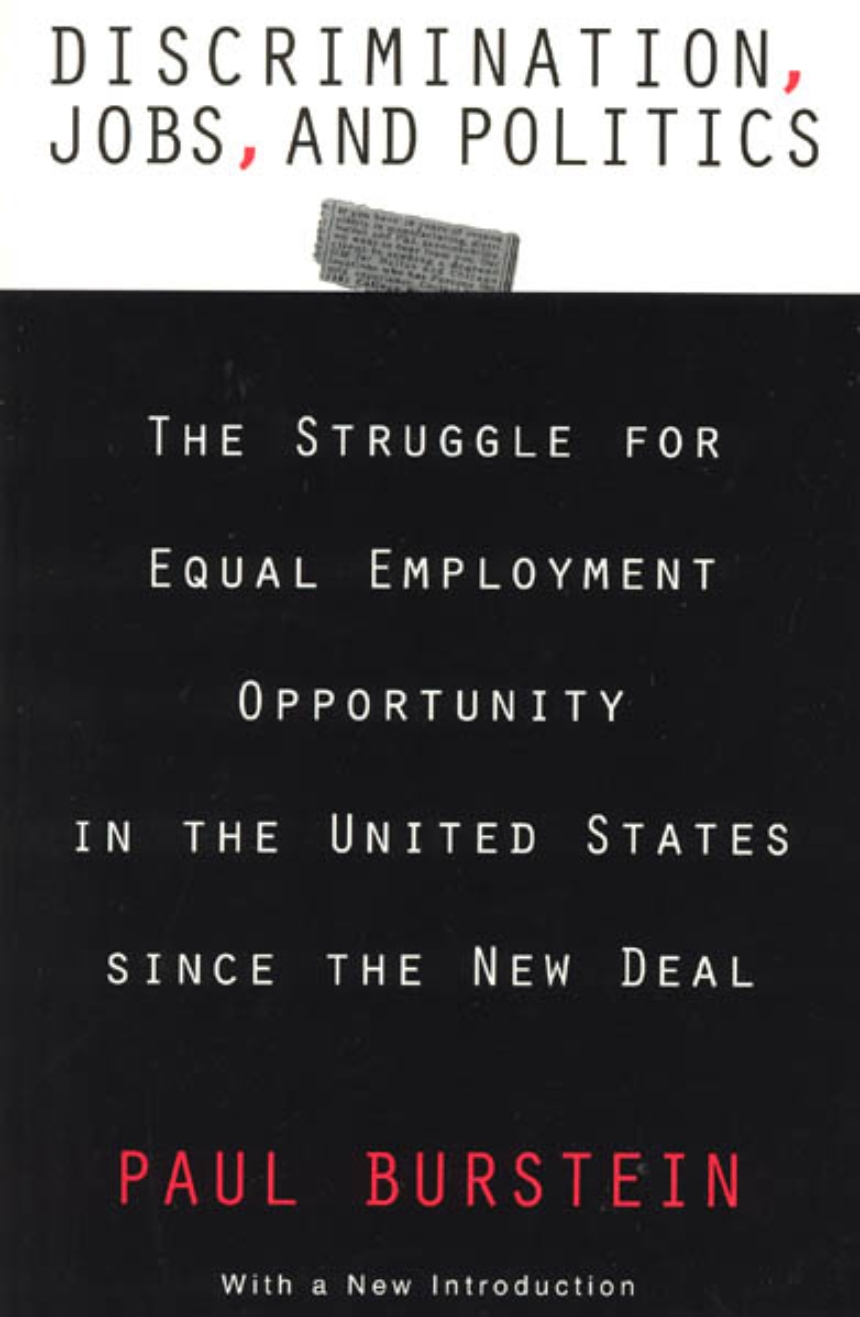Discrimination, Jobs, and Politics
The Struggle for Equal Employment Opportunity in the United States since the New Deal
9780226081366
Discrimination, Jobs, and Politics
The Struggle for Equal Employment Opportunity in the United States since the New Deal
Throughout this impressive and controversial account of the fight against job discrimination in the United States, Paul Burstein poses searching questions. Why did Congress adopt EEO legislation in the sixties and seventies? Has that legislation made a difference to the people it was intended to help? And what can the struggle for equal employment opportunity tell us about democracy in the United States?
"This is an important, well-researched book. . . . Burstein has had the courage to break through narrow specializations within sociology . . . and even to address the types of acceptable questions usually associated with three different disciplines (political science, sociology, and economics). . . . This book should be read by all professionals interested in political sociology and social movements."—Donald Tomaskovic-Devey, Social Forces
"Discrimination, Jobs and Politics [is] satisfying because it tells a more complete story . . . than does most sociological research. . . . I find myself returning to it when I’m studying the U.S. women’s movement and recommending it to students struggling to do coherent research."—Rachel Rosenfeld, Contemporary Sociology
"This is an important, well-researched book. . . . Burstein has had the courage to break through narrow specializations within sociology . . . and even to address the types of acceptable questions usually associated with three different disciplines (political science, sociology, and economics). . . . This book should be read by all professionals interested in political sociology and social movements."—Donald Tomaskovic-Devey, Social Forces
"Discrimination, Jobs and Politics [is] satisfying because it tells a more complete story . . . than does most sociological research. . . . I find myself returning to it when I’m studying the U.S. women’s movement and recommending it to students struggling to do coherent research."—Rachel Rosenfeld, Contemporary Sociology
290 pages | 21 line drawings, 24 tables | 5-1/2 x 8-1/2 | © 1985
Political Science: American Government and Politics
Sociology: Social Change, Social Movements, Political Sociology
Table of Contents
Preface
Introduction
1. Democratic Politics and Equality of Opportunity
What We Already Know
EEO Legislation: The Beginnings
A Preview
Some Caveats
2. Ideas and Politics in the Congressional Debate on Equal Employment Opportunity
The Beginnings of Congressional Action: Why the 1940s?
Legislating Equality: What Members of Congress Proposed
Growth of Support for EEO Legislation
The End of Legislative Activity
Conclusions: The Legislative Process
3. Public Opinion and Congressional Action
What the Public Wanted: Data
Public Opinion and Congressional Support for EEO
What the Public Wanted the Government to Do
The Intensity of Public Concern
Uncertainty, State Laws, and Congressional Support for EEO
Concurrent Majorities
Conclusions
4. The Civil Rights Movement and Congressional Action
The Civil Rights Movement
Collective Action, Media Coverage, and Congressional Action
Drama and Social Organization as Determinants of Congressional Action
Why Did Public Opinion Change?
What Congress Did
Conclusions
5. Elections, Lobbying, and Leadership
Elections
Lobbying
Leadership
A Note on the Structure of American Government
What Caused Public Opinion to Change? (Reprise)
Conclusions
6. Consequences of the Struggle for Equal Employment Opportunity
Possible Immediate Political Consequences of EEO Legislation
The Effect on Incomes of the Struggle for EEO
Conclusions
7. The Future of Equal Employment Opportunity
Why Income Gaps Always Close Slowly
Prejudice and Discrimination
Education
The Economy
Politics
Some Differences between Blacks and Women
Conclusions
8. Conclusions
The Struggle for Equal Employment Opportunity
Democratic Politics and the Struggle for Equality
The Limits of Political Action
Implications for the Study of Politics and Labor Markets
Summing Up
Appendix: Data from Congressional Hearings and the New York Times
Notes
References
Index
Introduction
1. Democratic Politics and Equality of Opportunity
What We Already Know
EEO Legislation: The Beginnings
A Preview
Some Caveats
2. Ideas and Politics in the Congressional Debate on Equal Employment Opportunity
The Beginnings of Congressional Action: Why the 1940s?
Legislating Equality: What Members of Congress Proposed
Growth of Support for EEO Legislation
The End of Legislative Activity
Conclusions: The Legislative Process
3. Public Opinion and Congressional Action
What the Public Wanted: Data
Public Opinion and Congressional Support for EEO
What the Public Wanted the Government to Do
The Intensity of Public Concern
Uncertainty, State Laws, and Congressional Support for EEO
Concurrent Majorities
Conclusions
4. The Civil Rights Movement and Congressional Action
The Civil Rights Movement
Collective Action, Media Coverage, and Congressional Action
Drama and Social Organization as Determinants of Congressional Action
Why Did Public Opinion Change?
What Congress Did
Conclusions
5. Elections, Lobbying, and Leadership
Elections
Lobbying
Leadership
A Note on the Structure of American Government
What Caused Public Opinion to Change? (Reprise)
Conclusions
6. Consequences of the Struggle for Equal Employment Opportunity
Possible Immediate Political Consequences of EEO Legislation
The Effect on Incomes of the Struggle for EEO
Conclusions
7. The Future of Equal Employment Opportunity
Why Income Gaps Always Close Slowly
Prejudice and Discrimination
Education
The Economy
Politics
Some Differences between Blacks and Women
Conclusions
8. Conclusions
The Struggle for Equal Employment Opportunity
Democratic Politics and the Struggle for Equality
The Limits of Political Action
Implications for the Study of Politics and Labor Markets
Summing Up
Appendix: Data from Congressional Hearings and the New York Times
Notes
References
Index
